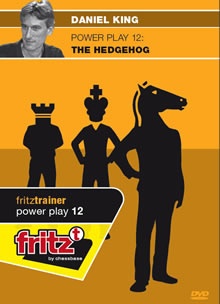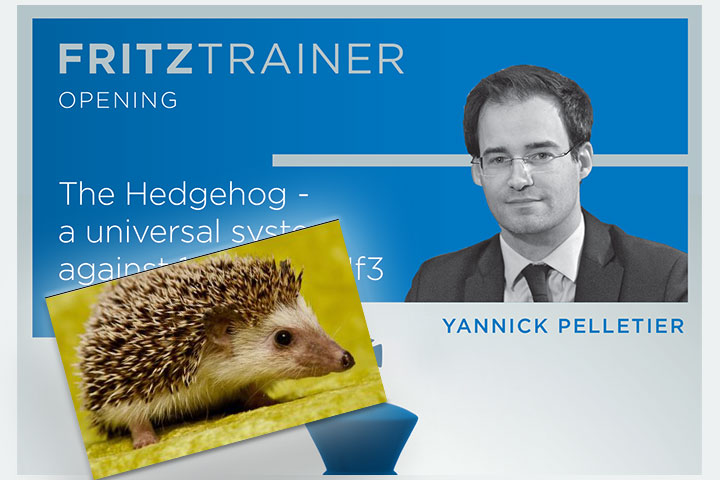Good enough to beat Magnus...
A review
I didn't know he won the Swiss National championship 5 times! It is nice that in the beginning of GM Pellettier's Hedgehog series, he informs us of his achievements and career — almost as nice as his French accent, which made me want revisit Paris!

Pellettier achievements in chess are so many that it would take an article just to mention them all; the funny part is that when he mentioned he won the German Bundesliga, a German accent entered his English, showing he speaks German as well — common among Swiss citizens. Why do I mention the languages? Because one of the most pleasant things in chess is that we are all one people — Gens Una Sumus, the FIDE motto reminds us — but we all speak different languages, and Pelletier has authored this same DVD in French and German too!
However one of the most impressive achievements is when Pelletier in 2015 beat Magnus Carlsen, with Black, using...drumroll please...the Hedgehog!
For those who have no clue about what the Hedgehog is, the diagram above is taken from the game against Carlsen, in which such a pawn structure appeared.
Here the complete game for those who are curious:
Pelletier structured the DVD using selected games by top GMs, where he explains the plans for both colors, but he also spent a good amount of time explaining the move order, because in order to achieve the maximum efficacy and advantage, the move order is very important. I noticed most of the top GMs spend a good amount of time around the move order. For example l'Ami in his DVD on the Dutch Stonewall spent several videos explaining the intricacies of the move order. L'Ami also proved how different move orders could bring Black an inferior position. One could think this works only at 2600+ rating level, but this is not the case, because often our opponents have been taking lessons by a GM, or just repeat the move order of their favorite player, putting us in a bad situation.
One advantage of this DVD (and indeed other's from Chessbase), is that we have that kind of in-depth explanation, not always found in books, and when these top GMs talk, and focus our attention on some moves, it becomes easier to remember them in our own games.
Most of the videos explain how to neutralize and deal with White's plans, because this is what we need to know in order to play this opening with confidence.
In brief, the DVD consists of one introductory video, two videos entitled "appetizer" in which we are shown some really amazing games, two videos just dedicated at the intricacies of the move order, and fifteen videos of illustrative games which explain how to actually play the Hedgehog. The DVD ends with eleven videos of quizzes, where Pelletier show us some positions, and ask to find the correct continuation, giving us feedback when we don't choose the right move. For example in the first video quiz begins with the question: "If White plays Bg2, how would you continue as Black?"

Think you know the answer?
The DVD comes with a database of 218 games that Pelletier has chosen for their educational value. Of these, 16 are games played by Pelletier himself as Black. But of course there are many other important names who have played a lot of games in such a database, including Garry Kasparov, Anatoly Karpov, and Sergei Shipov who is famous for having authored two books on the Hedgehog, and of course many others.
I find Pelletier's introductory video interesting because he clearly states that when we speak of the Hedgehog we mean a certain pawn structure — a system — and the reader of this review could be mislead into thinking it happens only with Black. One of the most beautiful games I've seen (obviously played by the best player of all time) illustrates the hedgehog played by White. Notice the opening is labeled as "Nimzo-Larsen Attack", but this is the structure you see:

Look familiar?
No other World Champion was more infamous both inside and outside the chess world than Bobby Fischer. On this DVD, a team of experts shows you the winning techniques and strategies employed by the 11th World Champion.
Grandmaster Dorian Rogozenco delves into Fischer’s openings, and retraces the development of his repertoire. What variations did Fischer play, and what sources did he use to arm himself against the best Soviet players? Mihail Marin explains Fischer’s particular style and his special strategic talent in annotated games against Spassky, Taimanov and other greats. Karsten Müller is not just a leading international endgame expert, but also a true Fischer connoisseur.
Pelletier mentions we can see the Hedgehog in Black's openings like the Sicilian or the Nimzo-Indian. In fact after the first 13 moves of one of the first games played with the Hedgehog, 1.e4 c5 2.Nf3 e6 3.d4 cxd4 4.Nxd4 a6 5.c4 Qc7 6.Nc3 Nf6 7.Be2 b6 8.Be3 Bb7 9.f3 d6 10.Qd2 Nbd7 11.O-O Be7 12.Rfd1 O-O 13.Rac1 Rac8 we reach this position:

Here is the entire game:
But could the Hedgehog be reached by other openings? Yes, here an example from the King's Indian 1.d4 Nf6 2.c4 g6 3.Nc3 Bg7 4.e4 d6 5.f3 O-O 6.Be3 Nbd7 7.Nge2 c5 8.Qd2 a69. Rd1 Qa5 10.Nc1 cxd4 11.Bxd4 Ne5 12.Nb3 Qc7 13.Rc1 e6 14.Be2 b6 15.O-O Bb7:

For which type of player is the Hedgehog a good opening? Pelletier in the beginning explains that one may like to play the Grunfeld against 1.d4 or the Benoni, or the Nimzo-Indian, but if White begins with 1.Nf3, or 1.c4, we cannot enter our pet openings on which we have worked so hard. Hence Pelletier proposes the Hedgehog as a universal system we can use against 1.c4 or 1.Nf3.
Pelletier while teaching the pawn structure, and control of the board, makes a good analogy showing with arrows what the Black pawns control, and how that can remind us of the animal giving the name to the hedgehog.

The interesting point of the Hedgehog is related to how it can confuse our opponents, because the hedgehog is not only a defensive formation, but can lead to a strong counter-attack, or activity within our own camp, which creates the basis for an attack.
For the reader of this review, especially interested in which material Pelletier is presenting, in the beginning he mentions that he will focus on lines of the English with g3 and Bg2, as from the following moves: 1.c4 c5 2.Nf3 Nf6 3.Nc3 e6 4.g3 b6 5.d4 cxd4 6.Qxd4 Bb7 7.Bg2 d6 8.0-0 Be7 9.e4 0-0 10.Qd3 a6 11.Nd4 Qc7 12.b3 Nbd7 13.Bb2:

Throughout the DVD, Pelletier explains to, and asks, the prospective Hedgehog player, to pay attention to where the black pieces are placed, helping us to see why on other squares that piece wouldn't do well. An example can be the b8-knight developed to d7.
If by mistake we develop the knight to c6, then Bb7 and Nf6 cannot put pressure on the e4-pawn. And of course there can also be tactical tricks on a knight placed in c6, which make such square undesirable for the development of our b8-knight. As a good teacher, Pelletier clarifies also possible exceptions to the explanation he just gave, making it easier to remember the reasons behind our moves.
Pelletier doesn't neglect to explain the meaning behind White's moves, and the rationale, as in the following case, where he mentions that the c4-pawn needs protection, and the move b2-b3 offers it, while at the same time opening the a1-h8 diagonal for the dark-squared bishop.

Often openings are mentioned negatively (because after all we should be studying endgames!), but notice the following image, an attack with "Garry" the g-pawn, very similar to the Sicilian because of the pawn structure, and in this case, the opening (for White) can teach how to attack the castled king. Yes, the point is: we can learn middlegame plans, and specific themes thanks to study an opening.

Pelletier does an amazing job in explaining what are the pawn thrusts for Black, and how they will challenge White's space advantage.

Before I forget, there was another ChessBase DVD with that great teacher by the name of Daniel King, also on the Hedgehog (in Powerplay 12). I believe in becoming exposed to as many teachers as possible, and in this case King also does a great job in explaining the important ideas of this system.
Final Thoughts
Pelletier has been playing the Hedgehog for over 20 years. As shown by the first game, he has beaten the absolute elite with this opening system, because it is a way to bring the opponent out of his own opening preparation, and ask him some tough questions, especially in the middlegame, where White could follow the wrong plan. Pelletier is also playing the English as White, and this gives him a better understanding to guide us through the maze of dangers White can pose to us.
At first glance, the Hedgehog setup might appear somewhat passive but in fact Black is always waiting to launch a counterattack. Let Yannick Pelletier provide you with a complete repertoire against the English and the Reti!
























